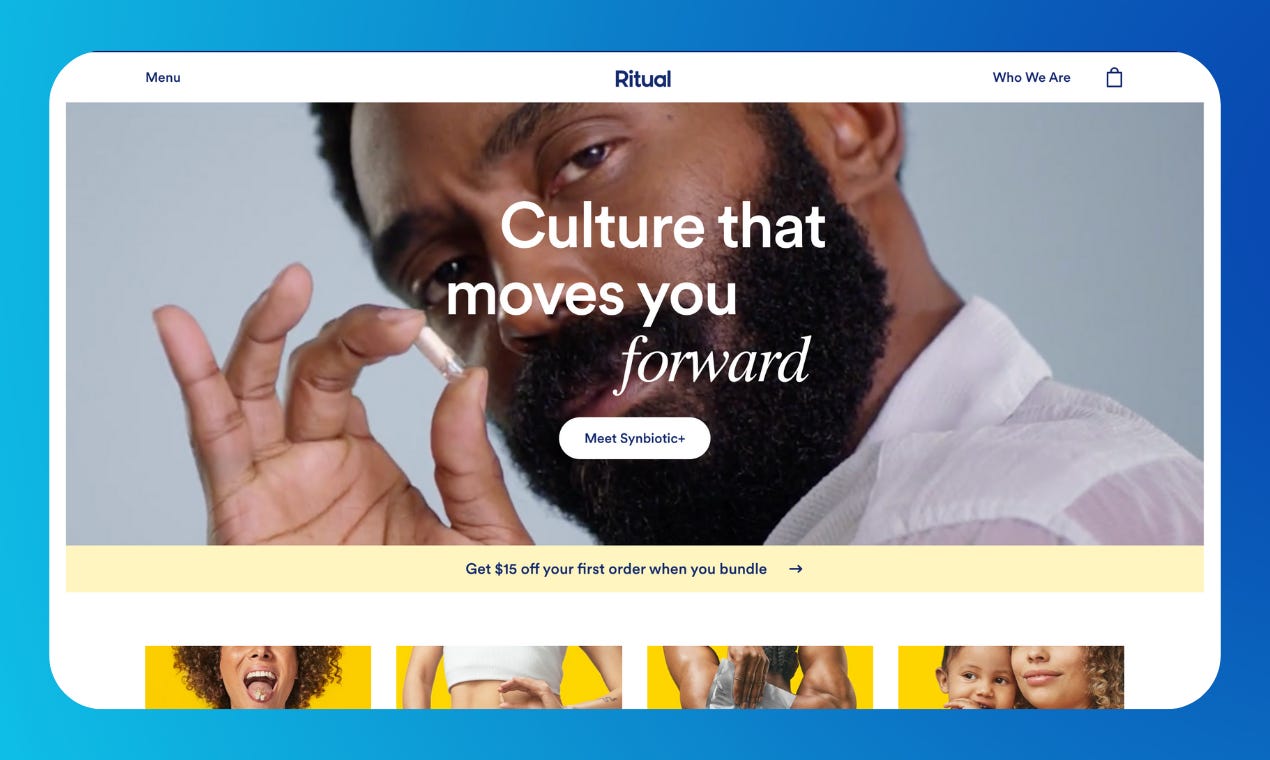How Would We Personalize Ritual Based on Product Recommendation Quiz
A small selection of recommended products helps overcome the paradox of choice
In this case study, we'll show you how we would personalize the web experience on Ritual's website to increase conversions by leveraging zero-party data via product recommendation quizzes and campaign-based personalization.
Before diving into the personalization, let's look at what Ritual does:
Ritual
Ritual is a supplement subscription service that’s well known for offering high-quality multivitamins.
While the original product line was geared toward adult women, Ritual has since expanded its supplement line to include products that meet the needs of men, women, and children.
The Background of the Personalization Journey
If you're a business, you know that attracting leads and retaining customers is essential to your success. Moreover, as a business, you understand the importance of understanding your visitors and what they want.
And if you're looking for ways to improve your conversion rates in a direct-to-consumer environment, leveraging zero-party data about customers’ preferences for personalization may be the answer.
Adding this layer of customer understanding to your website, you can create a more tailored experience for all of your visitors, regardless of who they are, which will improve engagement and conversion.
The Opportunity
Is it really necessary for businesses to personalize their website experiences for their potential customers?
The answer is a resounding yes, and here’s why.
There is a huge opportunity lying under personalized offers because according to research by Accenture, 91% of consumers say they are more likely to engage with brands that provide offers and recommendations that are relevant to them.
When done correctly, personalization can lead to higher conversion rates, as well as increased customer engagement and loyalty.
Adding Personalization Layer to Ritual’s Website
Step 1: The Tech Stack
To create the best possible personalization experiences for its visitors, Ritual needs to leverage the zero-party data from product recommendation quiz submissions and click events from social and display ads.
Moreover, in order to create the best possible personalized experience, Ritual will source all of the data points made by the same visitor under one customer profile - with the help of Ninetailed's unified customer profile feature.
For this personalized experience, Ritual will need the following tech stack:
Step 2: Defining Hypothesis and Methodology
Personalization is key to making sure the visitors are shown exactly what they need before making the desired action, which can help increase conversion rates.
Therefore..
We hypothesize that by personalizing the page elements based on campaign parameters and product recommendation quiz answers, in our case:
campaign parameters
gender
age
needs
other demographic and need-based data
Ritual can show its visitors personalized hero images with products, messages, offers, benefits, and case studies they're interested in - increasing the likelihood of potential visitors clicking through and making a conversion.
The bottom line, to create a personalized web experience, Ritual needs to leverage the zero-party data they acquire via product recommendation quizzes.
Step 3: Defining Personalization Signals
To create a seamless digital customer experience with a personalized web page, Ritual will use the following signals:
Age: Knowing the age of potential customers allows Ritual to target their audiences based on specific age range and life cycle stages:
Gender: Knowing the gender will allow Ritual to show the gender-relevant products.
Campaign Parameters
Step 4: Personalization Journey
To create a personalized web experience for Ritual’s visitors, let's define a hypothetical personalization journey:
A potential visitor sees an ad for Ritual on Instagram and clicks the ad.
A visitor lands on Ritual’s website and sees a personalized hero section based on campaign parameters.
The visitor starts taking a product recommendation quiz to see which vitamin best suits its needs.
After completing the quiz, the visitor sees a new version of the personalized homepage - focusing on the specific product with benefits, social proof, and related articles.
Read More: Using Personalized Content to Supercharge Conversion Rates
The Result: Before vs. After
So far, we have talked about the hypothesis, methodology, signals to use, and required technology stack.
Now let's look at the visuals to better understand it.
As we defined earlier, a potential visitor sees an ad for Ritual on Instagram and clicks the ad:
After clicking the ad, the visitor sees a personalized variation of the homepage based campaign parameters:
The visitor starts taking a product recommendation quiz to see which vitamin best suits its needs. After completing the quiz, the visitor sees a new version of the personalized homepage - focusing on the specific product with benefits, social proof, and related articles.
The Bottom Line
Although we showcased a very fundamental personalization based on firmographics, there are endless ways of personalization.
Personalization is a continuous journey, which means that once one implementation is completed, companies will return to the beginning of the framework to analyze acquired data, discuss new ideas, hypothesize further improvements, and so on.
Through continuous learning and experimentation, this strategy enables various teams
content marketing,
growth,
product management,
development
to create meaningful personalization experiences.








